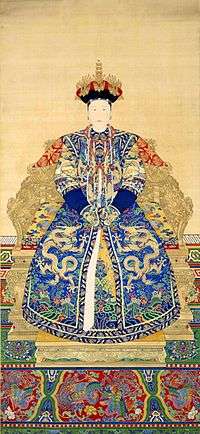Empress Xiaokangzhang
Empress Xiao Kang Zhang (1638 – 20 March 1663), of the Manchu Bordered Yellow Banner Tunggiya clan, was a consort of the Shunzhi Emperor.
| Empress Xiao Kang Zhang | |||||
|---|---|---|---|---|---|
| Holy Mother, Empress Dowager Cihe | |||||
 | |||||
| Empress dowager of Qing | |||||
| Tenure | 5 February 1661 – 20 March 1663 | ||||
| Predecessor | Empress Xiaoduanwen Empress Dowager Xiaozhuang | ||||
| Successor | Empress Xiaogongren | ||||
| Born | 1638 (崇德三年) | ||||
| Died | 20 March 1663 (aged 24–25) (康熙二年 二月 十一日) Forbidden City | ||||
| Burial | Xiao Mausoleum, Eastern Qing tombs | ||||
| Spouse | |||||
| Issue | Kangxi Emperor | ||||
| |||||
| House | Tong, later Tunggiya (佟佳; by birth) Aisin Gioro (by marriage) | ||||
| Father | Tulai (图赖) | ||||
| Mother | Lady Aisin Gioro | ||||
| Empress Xiaokangzhang | |||||||
|---|---|---|---|---|---|---|---|
| Chinese name | |||||||
| Traditional Chinese | 孝康章皇后 | ||||||
| Simplified Chinese | 孝康章皇后 | ||||||
| |||||||
| Manchu name | |||||||
| Manchu script | ᡥᡳᠶᠣᠣᡧᡠᠩᡤᠠ ᠨᡝᠰᡠᡴᡝᠨ ᡝᠯᡩᡝᠮᠪᡠᡥᡝ ᡥᡡᠸᠠᠩᡥᡝᠣ | ||||||
| Romanization | hiyoošngga nemgiyen eldembuhe hūwangheo | ||||||
Life
Family background
Empress Xiaokangzhang's personal name was not recorded in history. Her family originally belonged to the Han Chinese Plain Blue Banner. Although her family was of Jurchen descent, they had lived among Han Chinese for many generations and had been assimilated into Han Chinese society in Fushun, Liaoning, during the Ming dynasty, hence they were regarded as nikan (Han Chinese) by the Manchus and placed under a Han banner instead of a Manchu banner.
- Father: Tulai (圖賴; 1606–1658), served as a first rank military official (都統), and held the title of a first class duke (一等公)
- Paternal grandfather: Yangzhen (養真/养真; d. 1621)
- Mother: Lady Gioro
- Three brothers
- First younger brother: Guoji (国纪)
- Second younger brother: Guogang (国纲; d. 1690), served as a first rank military official (都统, pinyin: dutong) and held a title of first class duke (一等公)
- Third younger brother: Guowei (國維; d. 1719), served as a leader of imperial guards (領侍衛內大臣), and held the title of a first class duke (一等公), the father of Empress Xiaoyiren (d. 1689) and Imperial Noble Consort Quehui (1668–1743)
The Han Chinese Banner Tong 佟 clan of Fushun in Liaoning falsely claimed to be related to the Jurchen Manchu Tunggiya 佟佳 clan of Jilin, using this false claim to get themselves transferred to a Manchu banner in the reign of the Kangxi emperor.[1]
Shunzhi era
In 1653, Lady Tong entered the Forbidden City and became a concubine of the Shunzhi Emperor. She never received any title or rank during his reign. On 4 May 1654, she gave birth to the emperor's third son, Xuanye.
Kangxi era
When the Shunzhi Emperor died on 5 February 1661, Xuanye was chosen to be the new emperor and was enthroned as the Kangxi Emperor. As the birth mother of the reigning emperor, Lady Tong was honoured as "Holy Mother, Empress Dowager Cihe".
Lady Tong died on 20 March 1663. Her death was reportedly due to an unknown illness but the circumstances surrounding her death were suspicious.[2]Although she had never been Empress during the reign of the Shunzhi Emperor, she was granted the posthumous title "Empress Xiaokangzhang" by the Kangxi Emperor. She was interred in the Xiao Mausoleum alongside the Shunzhi Emperor and Consort Donggo.
Titles
- During the reign of Hong Taiji (r. 1626–1643):
- Lady Tong (from 1638)
- During the reign of the Kangxi Emperor (r. 1661–1722):
Issue
- As a concubine:
- Xuanye (玄燁; 4 May 1654 – 20 December 1722), the Shunzhi Emperor's third son, enthroned on 5 February 1661 as the Kangxi Emperor
In fiction and popular culture
- Portrayed by Chen Farong in The Duke of Mount Deer (2000)
- Portrayed by Zhu Yan in Kangxi Dynasty (2001)
- Portrayed by Jia Yumeng in Xiaozhuang Mishi (2003)
See also
- Ranks of imperial consorts in China#Qing
- Royal and noble ranks of the Qing dynasty
Notes
- Crossley, Pamela (June 1983). "restricted access The Tong in Two Worlds: Cultural Identities in Liaodong and Nurgan during the 13th-17th centuries". Ch'ing-shih wen-t'i. Johns Hopkins University Press. 4 (9): 21–46.
- Wu (1979), pp. 14–15, 195–96.
- 順治十八年 正月 七日
- 康熙二年 五月
- 康熙九年 五月
References
- Ho, Chuimei; Bronson, Bennet (2004). Splendors of China's Forbidden City: The Glorious Reign of Emperor Qianlong (Illustrated ed.). Merrell. ISBN 1858942039.
- Rawski, Evelyn S. (1998). The Last Emperors: A Social History of Qing Imperial Institutions (Reprint ed.). University of California Press. ISBN 052092679X.
- Ropp, Paul Stanley; Zamperini, Paola; Zurndorfer, Harriet Thelma (2001). Passionate Women: Female Suicide in Late Imperial China (Reprint ed.). BRILL. ISBN 9004120181.
- Wan, Yi; Shuqing, Wang; Yanzhen, Lu; Scott, Rosemary E. (1988). Daily Life in the Forbidden City: The Qing Dynasty, 1644–1912 (Illustrated ed.). Viking. ISBN 0670811645.
- Wu, Silas H. L. (1979). Passage to power: K'ang-hsi and his heir apparent, 1661–1722 (Illustrated ed.). Harvard University Press. ISBN 0674656253.
- Zhao, Erxun (1928). Draft History of Qing (Qing Shi Gao) (in Chinese).
| Chinese royalty | ||
|---|---|---|
| Preceded by Empress Dowager Xiaozhuang |
Empress Dowager of China 1661–1663 |
Succeeded by Empress Xiaohuizhang |
| Preceded by Empress Xiaohuizhang |
Empress of China Posthumous |
Succeeded by Consort Donggo (Empress Xiaochengren actual living successor) |